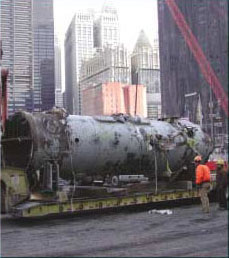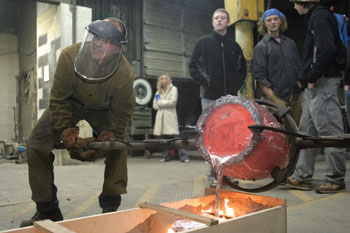 niurick schrieb:irre ich mich oder bist Du derjenige gewesen, der versucht hat, die "Explosionen" mit den Dieseltanks zu erklären?
niurick schrieb:irre ich mich oder bist Du derjenige gewesen, der versucht hat, die "Explosionen" mit den Dieseltanks zu erklären?
du irrst nicht nur, du phantasierst sogar !
zu WTC 1 & 2 war nie die Rede davon !!
Bei WTC 7 hat es noch gefehlt das unser SiBu meint den Dieseltank leugnen zu müssen ^^
NIST reviewed the report of an environmental contractor hired in the months after the collapse of WTC 7 to recover remaining fuel and mitigate any environmental damage from the second system’s two 6,000 gal tanks. The tanks were damaged and appeared to be empty and the report stated that neither the underground storage tanks nor their associated piping contained any residual petroleum product. No residual free product or sludge was observed in either underground storage tank. Evidence suggests that this fuel did not leak into the underground soil and contaminate it, and, therefore, could have been consumed in the building.
http://wtc.nist.gov/media/testimony/TestimonySept8_06.pdf Design, Installation, and Operation of Fuel Systems for Emergency Power in World Trade Center 7
http://wtc.nist.gov/NISTNCSTAR1-1J.pdfwas könnte auf folgendem Bild zu sehen sein ?
;)
Und hier noch ein paar nette Aussagen, die unsere VT-logen so nicht gerne unter das Volk bringen
:D"The rescue workers soon started referring to the ruins of the World Trade Center as “the pile.” While it was burning, they also referred to it as “the bitch” as in “the bitch is still burning.” The fires burned for three months after the attacks, and temperatures recorded from planes flying overhead reached as high as 2,000 degrees. Even after the external flames subsided, the bitch was insidious. Hollow “box beams” were used in the construction of the towers because they’re lighter than solid beams. But when these beams lay haphazardly within the pile, they acted like chimneys for the fires burning underneath and created a dangerous deception. Smoke rising in one place could be from a fire 30 to 40 feet away. Unsuspecting rescue workers often started digging right over hot spots, unintentionally giving oxygen to the glowing embers beneath the surface, igniting sudden geysers of flame.
Fleeing from these flare-ups was often as dangerous as facing the fire. The wreckage was very unstable, like a gigantic set of pickup sticks. Disturbing one steel beam or slab of concrete could easily touch off a collapse. For this reason, the rescue teams that searched through the pile worked in pairs. While one team would go down into the caverns under the pile, the other team would stand by up top just in case the first team had to be rescued."
Quelle:
http://www.eaenews.com/WillJimeno/the-will-jimeno-story-part-one/"Bobby Gray: "A 30-foot column carried high above the ground would be cherry red. It wasn't in a molten stage, but it was certainly too hot to put on a truck because the truck beds are all wood. We'd have to leave it on the side to cool. Sometimes the fire trucks would come by and hose them down." (Nine Months at Ground Zero, p. 66)"
Quelle:
http://multimedia.belointeractive.com/attack/news/0918firesburn.htmlWas aus dem Türmen konnte Brennen?
– Up to 180,000 gallons of fuel oil, diesel fuel and transformer oil (See varying estimates in links below)
– 2,000 automobiles and trucks. Not all were burned, but many were (I'm not aware of a count) Each one with fuel on board, each with four tires, foam and fabric upholstery and carpeting, engine oil, rubber hoses, belts, weatherstripping, wiring harnesses, loads of plastic, paint.
– Carpeting. Doesn't sound like a big deal. Imagine going into your local carpet dealer and asking for installation for your living room. Dimensions: 20 feet wide, 65 miles long.
– Tens of thousands of miles of wiring covered with plastic insulation.
– 5 million square feet of painted surfaces.
– Hundreds of tons of wood and particle board.
– Millions of pounds of paper
– 20,000 viscoelastic tower shock absorbers.
– Tens of thousands of computer terminals covered in plastic.
– Hundreds of tons of trading-floor equipment.
– Tens of thousands of telephones covered in plastic.
– Thousands of fax machines covered in plastic.
– Thousands of copiers and toner cartridges covered in plastic.
– Thousands of computer peripherals: printers, scanners, hubs, zip drives (remember them?), millions of CD-ROMs and floppy disks. User manuals for everything. Calculators. Everything covered in plastic.
– All of the electronics above have plastic-insulated wiring and plastic circuit boards.
– About 75,000 chairs, most with foam padding and synthetic coverings.
– Hundreds of upholstered couches.
– Millions of plastic pens and markers.
– Tens of thousands of cardboard boxes
– Tens of thousands of plastic wastebaskets
– Tons and tons of flammable mailroom supplies
– Hundreds of supply closets filled with office consumables, including untold quantities of paper and plastic.
– The contents of the receiving areas: perhaps thousands of boxes of supplies
– Thousands of flammable items used by repair and maintenance crews.
– The contents of over 75 retail stores, with all their merchandise, shelves and display cases, and back rooms filled with stock in boxes. These include 18 clothing stores, several bookstores, newsstands, card shops, two music stores (plastic!), two consumer electronics stores, pharmacies.
– The contents of Windows on the World, the highest-grossing restaurant in the U.S., with all of its supplies, oils, table linens, wall treatments, upholstered furniture, etc.
– The contents of numerous other restaurants, cafés and snack bars.
When you stop to think about it, it really adds up.
Und dazu noch ein paar gute Links, die hoffentlich noch alle funktionieren
http://www.gasandoil.com/goc/news/ntn20242.htmhttp://wardgriffin.com/fire.htm (Archiv-Version vom 01.11.2005)http://www.epa.gov/epaoswer/osw/meeting/pdf02/kahnp.pdf (Archiv-Version vom 22.04.2008)http://www.liquidminerals.com/fuels.htm (Archiv-Version vom 14.09.2008)http://www.mta.nyc.ny.us/capconstr/fstc/documents/deis/appendices/appendixl.pdfhttp://www.renewnyc.com/content/pdfs/ea/10_hazardous_materials.pdfhttp://www.renewnyc.com/content/pdfs/eis/Appendix_D.pdf (Archiv-Version vom 25.08.2008)http://wtc.nist.gov/pubs/WTC%20Part%20IIC%20-%20WTC%207%20Collapse%20Final.pdfhttp://www.osha.gov/Publications/OSHA3189/osha3189.html (Archiv-Version vom 06.07.2008)http://pubs.acs.org/cen/NCW/8142aerosols.htmlhttp://wtc.nist.gov/pubs/NISTNCSTAR1-1A.pdf







